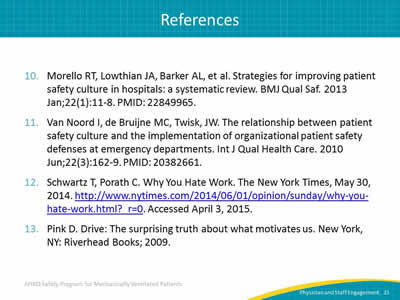Physician and Staff Engagement: Facilitator Guide
AHRQ Safety Program for Mechanically Ventilated Patients
Slide 1: Physician and Staff Engagement
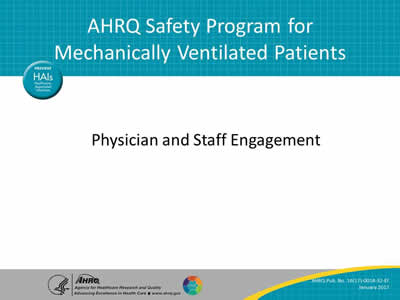
Say:
Today, we will give you an overview of physician and staff engagement.
Slide 2: Learning Objectives
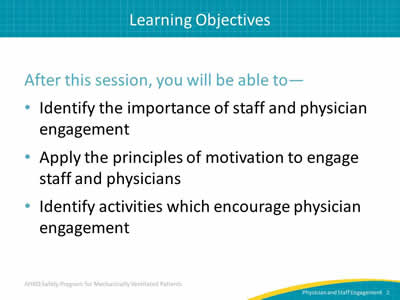
Say:
After this session, you will be able to identify the importance of staff and physician engagement, apply the principles of motivation to engage staff and physicians, and identify activities that encourage physician engagement.
Slide 3: Leading Change
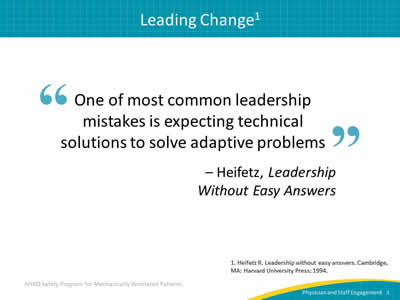
Say:
This is a quote from Ronald Heifetz’s book, Leadership Without Easy Answers.
"One of most common leadership mistakes is expecting technical solutions to solve adaptive problems…."
Slide 4: Technical and Adaptive Work
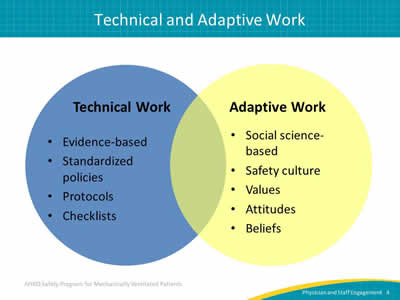
Say:
Our work needs to be informed by science, and we accomplish this by thinking about the technical and the adaptive work. The technical work is the list of evidence-based therapies we should ensure patients are receiving. These are the therapies many organizations have spent decades working into our system, creating standardized policies, protocols, and checklists. But it is also important to recognize that many of those tools, including checklists, only work if people are truly engaged and find value. To engage staff in these efforts, it is also necessary to focus on adaptive work.
Where does the adaptive work come from? Adaptive work comes from the social science field. It talks about the values, attitudes, and beliefs of frontline staff that guide our day-to-day decisions: what we find important, what we do, what we don't do, what we know that we'll be praised for, and what we know that we'll be punished for. These underlying values, attitudes, and beliefs really drive what happens in our unit every single day.
Slide 5: What Would It Look Like If We…
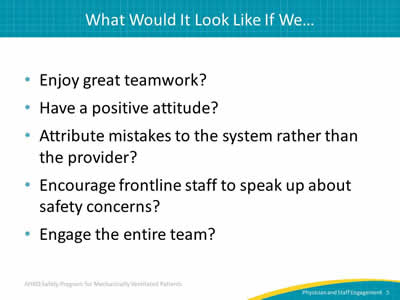
Say:
Good teamwork means recognizing that everyone has important insight and that their input is valued.
Ask:
What would it look like in your clinical area if we all had great teamwork?
What would it look like if we all came to work with a positive attitude?
What would it look like if mistakes weren't attributed to individual providers like physicians and nurses but if they were appropriately attributed to how we organize our health care system?
What would it look like if everyone—all the staff, the nurses, the physicians, the technicians—were empowered to speak up if they identified a concern resulting in patient harm?
What would it look like if everyone—physicians and nurses and staff—were truly engaged in doing this work together?
Say:
If we all pulled together around this issue and created a system that includes all of these examples, we would learn from our mistakes.
Slide 6: Teamwork Disconnect
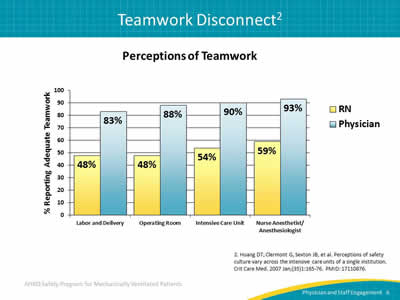
Say:
How comfortable people are speaking up represents our teamwork climate. There are significant discrepancies in how providers, clinicians, physicians, and nurses in particular view teamwork in the same clinical area. This graph is from a study published in the journal Critical Care Medicine. In labor and delivery, only about 48 percent of nurses said they have a good teamwork climate, but 83 percent of the physicians in the same clinical area thought they had a good teamwork climate. The same discrepancy is seen in the intensive care unit or ICU and in the operating room. This discrepancy is seen also in the operating room between nurse anesthetists and anesthesiologists.
Slide 7: Why Does Safety Culture Matter?
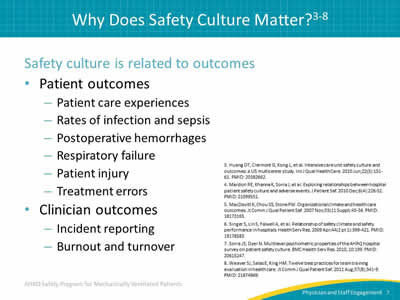
Say:
Poor safety and teamwork culture is linked to worse patient outcomes, including an increase in infection rates, sepsis, postoperative hemorrhage, respiratory failure, and treatment errors. Poor safety and teamwork culture is also linked to a lower rate of incident reporting and a higher rate of burnout and clinician turnover.
Slide 8: Why Does Safety Culture Matter?
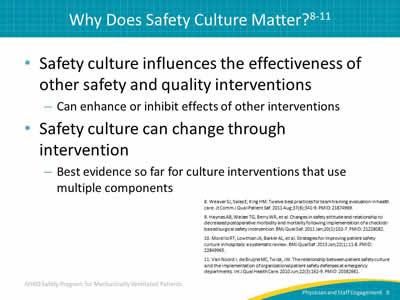
Say:
We know teamwork and safety culture influence the effectiveness of safety initiatives. If our teamwork is good, it can enhance the inner effects; if our teamwork is lacking, it will inhibit those effects. We also know that safety culture can change through interventions. A systematic review published in the Annals of Internal Medicine summarized that the best evidence from culture interventions comes from those that use multiple different components or multifaceted interventions.
Slide 9: Staff Engagement Matters
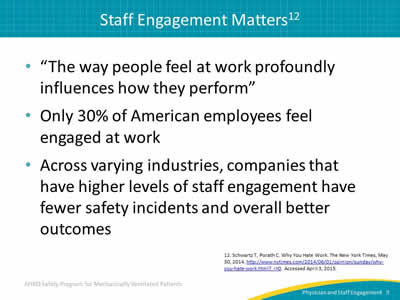
Ask:
Why does staff engagement matter?
Say:
The way we feel when we show up at work profoundly influences how well we do and what we do at work. An article from The New York Times examined a number of industries, not limited to health care, and found that only 30 percent of American employees feel engaged at work.
Ask:
Why is this problematic?
Say:
Industries and companies that have higher levels of staff engagement have fewer safety incidents and overall better outcomes.
Slide 10: Staff Engagement Matters
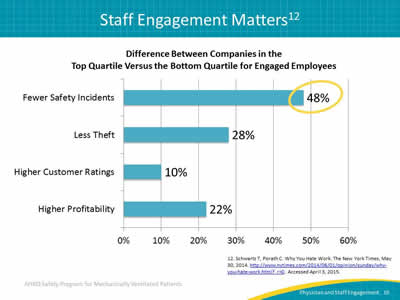
Say:
Citing a meta-analysis conducted in 2012 by Gallup, the same New York Times article reported 48 percent fewer safety incidents in those companies in the top quartile for engaged employees compared with those in the bottom quartile. Additionally, the rate of theft was lower and customer ratings and profitability were significantly higher in companies with engaged employees.
Slide 11: Engage
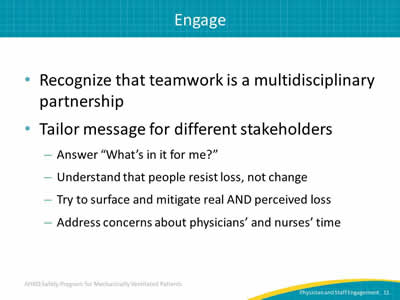
Ask:
How can we engage both physicians and staff?
Say:
Because teamwork is a multidisciplinary partnership, the message may need to be tailored for different stakeholders. Consider the "what’s in it for me?" factor to identify each stakeholder’s incentive to becoming more engaged. Help them find a niche where they feel valued, where their voices can be heard, and where they can see how it could benefit them.
Another challenge surrounding engagement is the idea that people do not like change.
Ask:
Is this really true?
Say:
Change is difficult but, in fact, what people fear is loss.
There are both real and perceived losses. When engaging people who resist change, we should try to identify and mitigate both real and perceived losses. For instance, a physician who resists enacting a new, nurse-driven ICU protocol may think the change will result in a loss of control when, in reality, the physician will retain the same amount of control he or she has always had. The loss of control is a perceived change that can create a barrier to physician engagement.
Loss of time is a concern for many doctors and nurses. The demand for time increasingly exceeds our capacity and drains us of the energy we need to bring our skill and talent fully to life.
Slide 12: Engage by Creating Trust
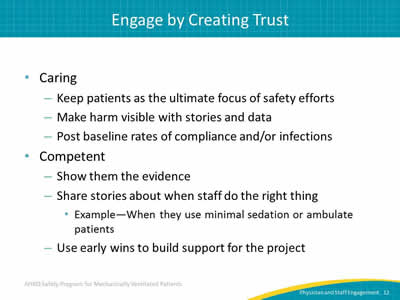
Say:
Nurses, physicians, and staff care deeply about patients. The vast majority are exceedingly competent as well as dedicated and passionate about the work that they do.
Ask:
How can we capitalize on that deep level of caring and competency in order to motivate engagement?
Say:
When addressing engagement through caring, one step is to keep patients as the "North Star" and the ultimate focus of our safety efforts. Another way is to make harm visible with stories and data that touch staff emotionally. One more way is to post baseline rates of compliance and/or infections. If staff is unaware of their unit’s actual performance, their lack of awareness prevents them from feeling compelled to improve it.
Ask:
How can staff competency be used as a means to promote engagement?
Say:
Providing staff with the evidence to support your efforts appeals to their desire to perform better. Sharing stories about staff member successes, such as using minimal sedation or ambulating a patient, helps to reinforce the behaviors we want to see. These successes can be highlighted on a bulletin board or flier, or by giving them the opportunity to speak at a local management meeting. Acknowledging the competency of your staff through encouragement and support is an important part of motivating them to continue doing the right things. Celebrate early wins to draw attention to what is rewarded and recognized within your organization.
Slide 13: Intrinsic Versus Extrinsic Motivation
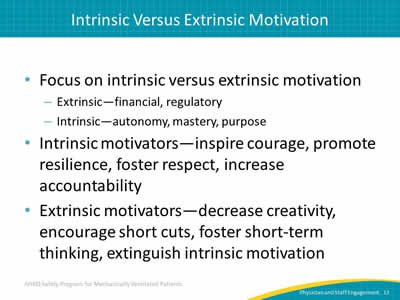
Say:
It is important to focus on the difference between intrinsic versus extrinsic motivation. Extrinsic motivators are things like financial or regulatory pressures. Intrinsic motivators focus on concepts such as autonomy, mastery, and purpose. Many studies have been done that show extrinsic motivators are counterproductive.
Ask:
Why is this?
Say:
Extrinsic motivators decrease creativity, encourage taking short cuts to achieve goals, and foster short-term thinking as opposed to examining a broader scope. Overall, extrinsic motivation has been shown to extinguish intrinsic motivation overall.
Intrinsic motivators, on the other hand, inspire courage, promote resilience, and foster respect. They increase accountability by speaking to our desire to have control over what we do and to be better at what we do. Focusing on intrinsic motivators as opposed to extrinsic motivators gives people the sense they have a common purpose and are part of something bigger.
Slide 14: What Motivates Human Beings?
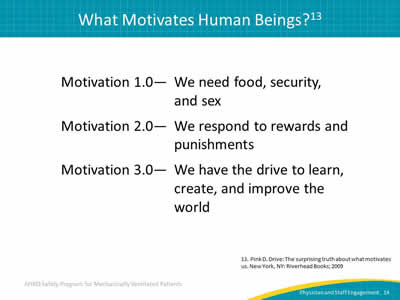
Say:
Over time, societies have developed sets of assumptions and protocols about how the world works and how humans behave that influence laws, economic arrangements, and business practices. These assumptions have led to many theories on what actually motivates human beings.
Ask:
What are some of these assumptions which guide common theories regarding human motivation?
Say:
One assumption is that we are motivated by our most basic human needs: food, security, and sex. The second assumption is that we respond to rewards and punishments and both can be used to encourage motivation. The third assumption is that humans are driven to succeed and progress by our desires to learn, create, and improve the world.
Daniel Pink, a best-selling author and expert on business, work, and management, theorizes the most effective way to achieve sustainable motivation is to focus on the third assumption.
Pink’s theory draws from research conducted at the Massachusetts Institute of Technology which suggests that when tasks involve higher order thinking, such as the tasks involved in this safety program, intrinsic motivators are more effective than extrinsic motivators when the goal is increasing worker performance and satisfaction.
Slide 15: What Motivates Human Beings?
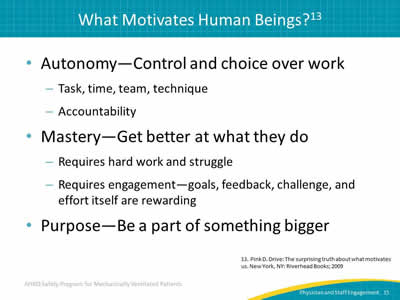
Say:
There are three principle intrinsic motivators: autonomy, mastery, and purpose.
Autonomy means that we have control and choice over what we do, including our tasks, time, teams, and techniques. Mastery means that people want to get better at what they do. Mastery requires hard work and struggle, but the challenge and effort itself is rewarding. Purpose means we desire to be part of something bigger than ourselves.
Slide 16: Try This
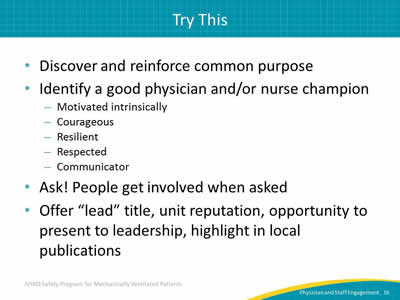
Say:
If you are having trouble engaging your physicians and your staff, continue to reinforce your common purpose of creating a safer environment for mechanically ventilated patients and prompting your staff to ask what it would be like if everyone worked better together having that common purpose in mind.
Ask:
How else can you try to engage your staff when you encounter barriers?
Say:
Try to find at least one good physician or a nurse who is intrinsically motivated. Those who are intrinsically motivated are most often courageous, resilient, respected amongst their peers, and good communicators. Reach out to that person and ask them to get involved and apply these principles. People usually will get involved when asked, but you have to ask first! Finally, when working to engage people, speak to those internal motivators by giving them some type of recognition. Giving them a lead title, helping them to establish some unit reputation, giving them an opportunity to present leadership, or highlighting them in a local publication are all ways to harness internal motivation.
Slide 17: Fostering Physician Engagement
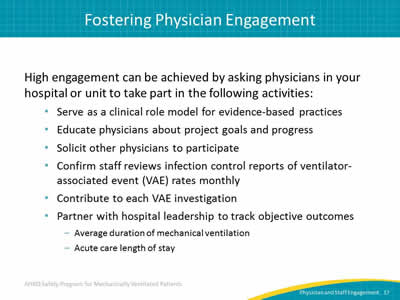
Ask:
What are some activities you can do to specifically encourage the engagement of physicians in your unit?
Say:
You can ask them to serve as a clinical role model for evidence-based practices or to educate other physicians on unit goals and progress. Encourage them to solicit other physicians to participate in your efforts. More clinically based ways to foster engagement are to enlist the physician to confirm staff review of infection control reports of monthly ventilator-associated event (VAE) rates and to contribute to each VAE investigation. Another important activity that promotes engagement is to ask the physician to partner with hospital leadership to track objective outcomes, such as the average duration of mechanical ventilation and the acute care length of stay.
Slide 18: Checklist for Engaged Physicians
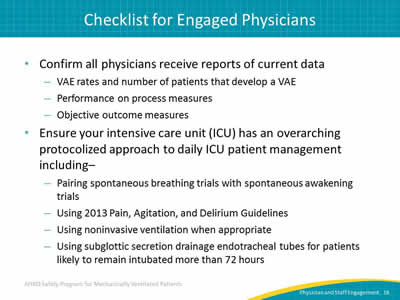
Say:
There are a variety of different tasks which physicians can use to engage other physician colleagues, particularly focusing on the technical piece—care of mechanically ventilated patients and all the evidence-based processes—as well as the adaptive piece of Comprehensive Unit-based Safety Program (CUSP) implementation.
One important task to consider is confirming that all physicians receive reports of current data. This includes VAE rates and the number of patients that develop a VAE, performance on process measures, and objective outcome measures. A second task is ensuring your intensive care unit (ICU) has an overarching, protocolized approach to daily ICU management. This includes pairing spontaneous breathing trials with spontaneous awakening trials, using non-invasive ventilation when appropriate, and using subglottic secretion drainage endotracheal tubes for patients likely to be intubated for more than 72 hours.
Slide 19: Engagement of the CUSP Physician Champion
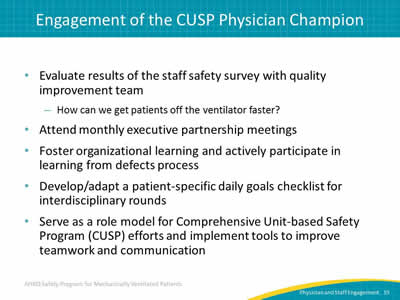
Say:
For the adaptive piece—the implementation of CUSP— there are also several tasks for physician champions to undertake in order to boost their engagement. Physician champions should evaluate the results of the staff safety survey with their quality improvement team, keeping in mind the question of how to get patients off the ventilator faster. They should attend monthly executive partnership meetings whenever possible. Physician champions can engage further by fostering organizational learning. They should become active participants in the learning from defects process, by developing or adapting a preexisting patient-specific daily goals checklist for use during interdisciplinary rounds. Finally, by serving as a role model for CUSP efforts and by implementing tools to improve teamwork and communication, physician champions can encourage their colleagues to participate in quality improvement efforts.
Slide 20: Questions?

Ask:
Do you have any questions following this module?
Slide 21: References
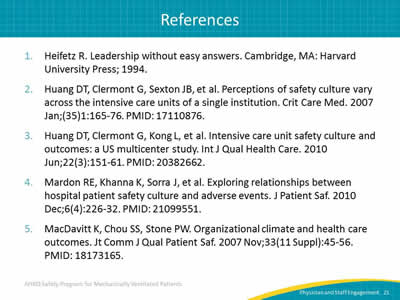
Slide 22: References
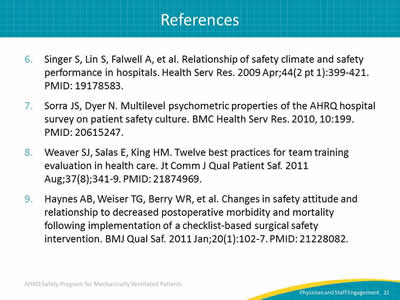
Slide 23: References
